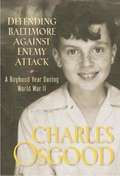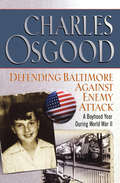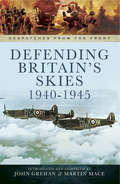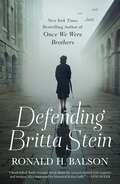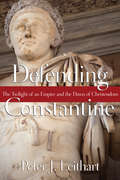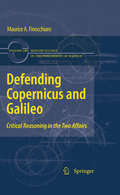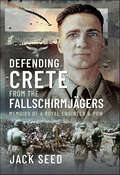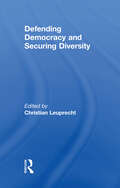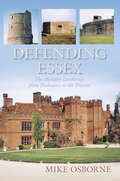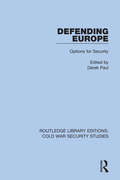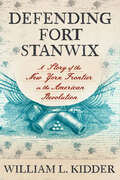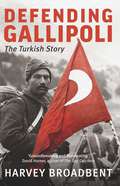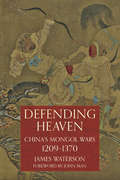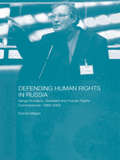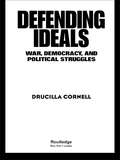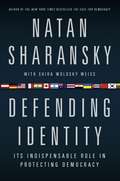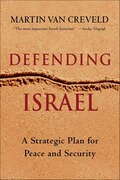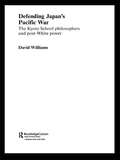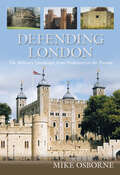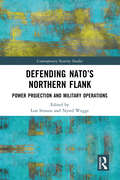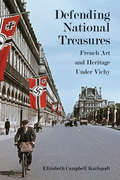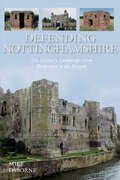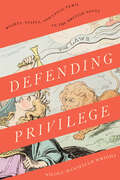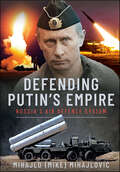- Table View
- List View
Defending Baltimore Against Enemy Attack
by Charles Osgood1942. the nation is reeling from the first blows of World War II, nine-year-old Charlie spends his days planting victory gardens, collecting scrap metal, going to ball games and goofing around.
Defending Baltimore Against Enemy Attack: A Boyhood Year During World War II
by Charles OsgoodFrom beloved broadcaster Charles Osgood, a poignant memoir about one unforgettable childhood year during World War II. Defending Baltimore Against Enemy Attack is a gloriously funny and nostalgic slice of American life and a moving look at World War II from the perspective of a child far away from the fighting, but very conscious of the reverberations. With a sharp eye for details, Osgood captures the texture of life in a bygone era.
Defending Britain's Skies, 1940–1945 (Despatches from the Front)
by Martin Mace John GrehanDespatches in this volume include that on the Battle of Britain, and air fighting 1940-1941, by Air Chief Marshal Sir Hugh C.T. Dowding, Air Officer Commanding-in-Chief, Fighter Command, Air Operations by Fighter Command between November 1940 and the end of December 1941, the anti-aircraft defence of the United Kingdom between 1939 and 1945, and the report on air operations by Air Defence of Great Britain and Fighter Command in connection with the German flying bomb and rocket offensives, 1944-1945.This unique collection of original documents will prove to be an invaluable resource for historians, students and all those interested in what was one of the most significant periods in British military history.
Defending Britta Stein: A Novel (Liam Taggart and Catherine Lockhart #6)
by Ronald H. BalsonOne of Newsweek's 20 New Books to Cozy Up With this FallDefending Britta Stein is a story of bravery, betrayal, and redemption—from Ronald H. Balson, the winner of the National Jewish Book AwardChicago, 2018: Ole Henryks, a popular restauranteur, is set to be honored by the Danish/American Association for his many civic and charitable contributions. Frequently appearing on local TV, he is well known for his actions in Nazi-occupied Denmark during World War II—most consider him a hero.Britta Stein, however, does not. The ninety-year-old Chicago woman levels public accusations against Henryks by spray-painting “Coward,” “Traitor,” “Collaborator,” and “War Criminal” on the walls of his restaurant. Mrs. Stein is ultimately taken into custody and charged with criminal defacement of property. She also becomes the target of a bitter lawsuit filed by Henryks and his son, accusing her of defamation and intentional infliction of emotional distress.Attorney Catherine Lockhart, though hesitant at first, agrees to take up Mrs. Stein's defense. With the help of her investigator husband, Liam Taggart, Lockhart must reach back into wartime Denmark and locate evidence that proves Mrs. Stein's innocence. Defending Britta Stein is critically-acclaimed author Ronald H. Balson's thrilling take on a modern day courtroom drama, and a masterful rendition of Denmark’s wartime heroics.
Defending Constantine: The Twilight of an Empire and the Dawn of Christendom
by Peter J. LeithartWe know that Constantine issued the Edict of Milan in 313 outlawed paganism and made Christianity the official religion of the Roman Empire manipulated the Council of Nicea in 325 exercised absolute authority over the church, co-opting it for the aims of empire And if Constantine the emperor were not problem enough, we all know that Constantinianism has been very bad for the church. Or do we know these things? Peter Leithart weighs these claims and finds them wanting. And what's more, in focusing on these historical mirages we have failed to notice the true significance of Constantine and Rome baptized. For beneath the surface of this contested story there emerges a deeper narrative of the end of Roman sacrifice--a tectonic shift in the political theology of an empire--and with far-reaching implications. In this probing and informative book Peter Leithart examines the real Constantine, weighs the charges against Constantinianism, and sets the terms for a new conversation about this pivotal emperor and the Christendom that emerged.
Defending Copernicus and Galileo
by Maurice A. FinocchiaroAlthough recent works on Galileo's trial have reached new heights of erudition, documentation, and sophistication, they often exhibit inflated complexities, neglect 400 years of historiography, or make little effort to learn from Galileo. This book strives to avoid such lacunae by judiciously comparing and contrasting the two Galileo affairs, that is, the original controversy over the earth's motion ending with his condemnation by the Inquisition in 1633, and the subsequent controversy over the rightness of that condemnation continuing to our day. The book argues that the Copernican Revolution required that the hypothesis of the earth's motion be not only constructively supported with new reasons and evidence, but also critically defended from numerous old and new objections. This defense in turn required not only the destructive refutation, but also the appreciative understanding of those objections in all their strength. A major Galilean accomplishment was to elaborate such a reasoned, critical, and fair-minded defense of Copernicanism. Galileo's trial can be interpreted as a series of ecclesiastic attempts to stop him from so defending Copernicus. And an essential thread of the subsequent controversy has been the emergence of many arguments claiming that his condemnation was right, as well as defenses of Galileo from such criticisms. The book's particular yet overarching thesis is that today the proper defense of Galileo can and should have the reasoned, critical, and fair-minded character which his own defense of Copernicus had.
Defending Crete from the Fallschirmjagers: Memoirs of a Royal Engineer & POW
by Andrew G. Taylor Jack SeedBy the spring of 1941, the enemy had taken much of Southern Europe: Bulgaria, Yugoslavia, Albania, Greece, and with Italy in the Axis it stood to dominate. The powerful British Naval Fleet and the amassed allied infantry of Britain, New Zealand, Australia, disposed Greeks, and the good people of Crete stood between the Axis powers and total control of the Mediterranean. This is the story of a soldier involved in the defense of Crete. The Luftwaffe commanded the air with their Stuka, Junkers and the formidable German Paratroopers: the Fallschirmjäger. It begins with Jack Seed’s part, as a Royal Engineer, in the Balkan Campaign of 1941. Starting with an account of the defense of Crete, it tells of the retreat from an overpowering enemy and of a determined survival until the victorious moments of the war’s end. Along with his comrades, Jack was taken prisoner of war and moved from Stalag to Stalag in railway trucks, enduring terrible hardships at the hands of his German captors for four years. With barely enough food to keep body and soul together, he and his fellow captives were sent out in gangs to work, often in perishingly cold conditions. They devised ways of getting extra food, but their schemes were often discovered by the German guards. They burnt the wood from their bunks in order to keep warm at night. They grew weak and weary and wondered how much more hardship they could stand. But finally, Hitler was dead, Germany had surrendered and the war was over. Within days, Jack was bound for home, flying over the white cliffs of Dover. He had survived. Jack Seed wrote his Second World War memoir during the 1970s, typing two copies for posterity on a mechanical typewriter. Like many with such experiences, his writing was not for any notion of reward, but to formalise his own lasting experience of the Second World War. Now, almost eighty years later, that story is shared.
Defending Democracy and Securing Diversity
by David Mason Christian Leuprecht Alan Okros Lindy Heinecken Christopher Dandeker David Last Victoria Marie Basham Karen D. Davis Jelle van den Berg Rudy Richardson Liora Sion Anne Irwin Joan Mars NoëLle Van Der Wagg-Cowling Donna WinslowOld sergeants say, "we're here to defend democracy, not to practice it!" But are they right? The special mandate with which defence and security organizations are tasked imposes unique constraints with respect to the accommodation of diversity which differs from those faced by any other public or private organization. Yet, the compound effect of demographic, political, economic, social and legal pressures is making diversity as inevitable in the defence and security sector as in any other organization in advanced industrialized democracies. Owing in part to a dearth of research on the way the defence and security sectors can leverage diversity to enhance their functional imperatives, such sectors have been reticent about diversity. The chapters in this volume strive to enlighten the debate by laying out the concepts, clarifying theoretical issues, and providing empirical evidence. The case studies draw on Canada, Guyana, the Netherlands, South Africa, and the United Kingdom. They examine ethno-cultural, gender, and sexual-minority diversity in a variety of missions, including Bosnia-Herzegovina and Afghanistan. The chapters are notable for their methodological pluralism and interdisciplinary range including political science, sociology, anthropology, and psychology. Although scholarly in nature, the book is readily accessible to professionals and practitioners alike. This book was published as a special issue of Commonwealth and Comparative Politics.
Defending Essex: The Military Landscape from Prehistory to the Present
by Mike OsborneFor 2,000 years Essex, the county with the longest coast-line in England and dominating the eastern approaches to London, has been in the front-line against foreign invasion, from the Romans to the Spanish Armada to the two World Wars. It has also been involved in civil disorder, from the Anarchy and the Peasants’ Revolt to the English Civil War. Many reminders of these scenes of conflict may be seen in the landscape - Iron Age forts, a Roman walled town, medieval castles, strong-houses and homestead moats, coastal fortifications from Napoleonic times and earlier, and Victorian barracks and the drill halls of the Volunteers. From the twentieth century there are still more sites: military airfields from the First World War and Battle of Britain fighter airfields, radar sites and later bomber bases from the Second. Anti-invasion defenses line the coast, linear defenses criss-cross the landscape, and AA sites are everywhere to be found. Taking the story all the way up to the nuclear threat of the Cold War, this guide will interest residents and visitors alike.
Defending Europe: Options for Security (Routledge Library Editions: Cold War Security Studies #21)
by Derek PaulThis book, first published in 1985, examines the questions of European security that lie at the heart of the confrontation between the superpowers. It concentrates on ways of achieving defence by conventional means rather than a reliance on nuclear or chemical weapons, and at the same time focuses on possible force reductions.
Defending Fort Stanwix: A Story of the New York Frontier in the American Revolution
by William L. KidderIn Defending Fort Stanwix, William L. Kidder tells the dramatic story of "the fort that never surrendered" and the crucial role it played in the American War for Independence. After a series of military defeats over the winter of 1776–1777, British military leaders developed a bold plan to gain control of the Hudson River and divide New England from the rest of the colonies. Three armies would converge on Albany: one under Lieutenant General John Burgoyne moving south from Quebec, one under General William Howe moving north from New York City, and a third under Lieutenant Colonel Barrimore St. Leger cutting east from Lake Ontario along the Mohawk River. Fort Stanwix lay directly on the path of St. Leger's force, making it a key defensive position for the Continental Army. By delaying St. Leger's troops and forcing a retreat, the garrison's stand at Fort Stanwix contributed to Burgoyne's surrender at the Battles of Saratoga a month later, a major turning point in the course of the war.Kidder offers an engaging account of life in and around the fort in the months leading up to the siege, detailing the lives of soldiers and their families, civilians, and the Haudenosaunee peoples with a focus on both the mundane aspects of military life and the courageous actions that earned distinction. Defending Fort Stanwix relates the stories of local men and women, both white and Indian, who helped with the fort's defense before, during, and after the siege and showcases an exciting, overlooked story of bravery and cooperation on New York's frontier during the American Revolution.
Defending French in Flanders, 1873–1974: Between Liberty and Identity
by David J. HensleyThis book examines the efforts of the French-speaking minority in Flanders, Belgium, to maintain a legal and social presence of the French language in Flemish public life. Chronologically, the study is bookended by two developments, almost exactly a century apart. In 1873, the first laws were passed which required the use of Dutch in some aspects of public administration in Flanders, challenging the de facto use of French among the Flemish ruling class. One hundred and one years later, the last French daily newspaper in Flanders collapsed, marking the end of a once-vibrant French-language public sphere in Flanders. The author contends that the methods and arguments by which French speakers defended the role of French in Flemish public life changed along with the social and political situation of this minority. As the Flemish movement grew over the course of the twentieth century, French speakers’ appeals to the “free choice” of language lost traction, and they put forward claims that they represented an ethnolinguistic minority who deserved protection for their mother tongue. Providing new insights for scholars of European history, and in conversation with the literature on liberalism, national identity, and Francophonie, this book demonstrates how the debate over the role of French in Flanders was at the center of Belgium’s ethnolinguistic conflict – the repercussions of which continue to be felt to this day.
Defending Gallipoli: The Turkish Story
by Harvey BroadbentBased on exclusive access to Turkish archives, Defending Gallipoli reveals how the Turks reacted and defended Gallipoli. Author and Turkish language expert Harvey Broadbent spent five years translating everything from official records to soldiers' personal diaries and letters to unearth the Turkish story. It is chilling and revealing to see this famous battle in Australian history through the 'enemy' lens. The book commences with a jihad, which sees the soldiers fighting for country and God together. But it also humanises the Turkish soldiers, naming them, revealing their emotions, and ultimately shows how the Allies totally misunderstood and underestimated them Defending Gallipoli fills a huge gap in the history of the Gallipoli campaign.
Defending Heaven: China's Mongol Wars, 1209-1370
by James Waterson&“A very readable account of the protracted and ultimately unsuccessful efforts of the Song, Xia, and Jin dynasties to defend China from the Mongols.&”—StrategyPage Defending Heaven brings together, for the first time in one volume, the complete histories of the wars the Jin, Song, Xia, and Ming dynasties fought against the Mongols. Lasting nearly two centuries, these wars, fought to defend Chinese civilization against a brutal and unrelenting foe, pitted personal heroics against the inexorable Mongol war machine and involved every part of the Chinese state. The resistance of the Chinese dynasties to the Khans is a complex and rich story of shifting alliances and political scheming, vast armies and navies, bloody battles and an astonishing technological revolution. The great events of China&’s Mongol war are described and analyzed, detailing their immediate and later implications for Chinese history. In this excellent new book, James Waterson tackles this fascinating subject with characteristic verve and skill. Setting the Mongol war in the wider context of China&’s ancient and almost perpetual conflict with the northern nomads, it sheds light on the evolution of China&’s military society and the management, command, and control of the army by the Chinese state. &“An excellent contribution not only to the study of the Mongol Empire but also to military history . . . Anyone interested in medieval warfare will find Defending Heaven of interest.&”—Professor Timothy May, in De Re Militari
Defending Human Rights in Russia: Sergei Kovalyov, Dissident and Human Rights Commissioner, 1969-2003 (BASEES/Routledge Series on Russian and East European Studies)
by Emma GilliganSergei Kovalyov is a central figure in the struggle for human rights in Russia. He was a leading Soviet biology academic and, in the 1970s after becoming active in dissident circles, was arrested by the KGB, tried, imprisoned and subjected to internal exile. After his release, he continued to work for human rights, eventually becoming chairman of the Soviet Human Rights Committee and chairman of the Presidential Human Rights Commission, in which positions he was extremely influential in framing human rights provisions in post-Communist Russia. He subsequently took President Yeltsin to task for human rights failings, eventually resigning in protest. This book, by tracing Kovalyov's political career, shows how human rights developed in Russia in late Soviet and post Soviet times.
Defending Ideals: War, Democracy, and Political Struggles
by Drucilla CornellIn this book, Drucilla Cornell examines the crisis on the left and asks how we can turn back toward more left-wing ideals. She looks at the meaning of freedom through various lenses as well as the dissolution of feminism. She discusses and critiques such major thinkers as: Amartya Sen, Adorno, Martha Nussbaum, John Rawls, Richard Falk, and Paul Berman among others.
Defending Identity: Its Indispensable Role in Protecting Democracy
by Natan SharanskyWho is better prepared to confront challenges and defend principles in a volatile modern world? Those with strong national, religious, ethnic, or tribal identities who accept democracy, or democrats who renounce identity as a kind of divisive prejudice? Natan Sharansky, building on his personal experience as a dissident, argues that valueless cosmopolitanism, even in democracies, is dangerous. Better to have hostile identities framed by democracy than democrats indifferent to identity. In a vigorous insightful challenge to the left and right alike, Natan Sharansky, as he has proved repeatedly, is at the leading edge of the issues that frame our time.
Defending Israel: A Strategic Plan for Peace and Security
by Martin van CreveldIsrael is a tiny country. From tip to toe, it stretches 260 miles long but is only 60 miles at its widest point. Since the days of the British mandate, the question of "defensible borders" for the Jewish state has always been problematic. Yet considering the larger picture of what has happened in the Middle East over the last 25 years -- the peace treaties with Egypt and Jordan, the weakening of Syria as a result of the collapse of the USSR, the smashing of Iraq by the U.S. -- Israel is, militarily speaking, stronger than ever before. The greatest remaining threats are terrorism and guerilla warfare; and those, this book argues, are best dealt with territorial concessions. Martin van Creveld's Defending Israel is a compact, incisive study that is certain to draw attention.
Defending Japan's Pacific War: The Kyoto School Philosophers and Post-White Power
by David WilliamsThis book puts forward a revisionist view of Japanese wartime thinking. It seeks to explore why Japanese intellectuals, historians and philosophers of the time insisted that Japan had to turn its back on the West and attack the United States and the British Empire. Based on a close reading of the texts written by members of the highly influential Kyoto School, and revisiting the dialogue between the Kyoto School and the German philosopher Heidegger, it argues that the work of Kyoto thinkers cannot be dismissed as mere fascist propaganda, and that this work, in which race is a key theme, constitutes a reasoned case for a post-White world. The author also argues that this theme is increasingly relevant at present, as demographic changes are set to transform the political and social landscape of North America and Western Europe over the next fifty years.
Defending London: The Military Landscape from Prehistory to the Presenr
by Mike OsborneFor two thousand years London has been at the heart of Britain’s development as a nation, providing a focus for its political life. The military element is now usually visible only through the pageantry which attends royal occasions, but this masks a more serious underlying intent. Frequently the target for both foreign invaders and domestic factions, it has been required to defend itself against everything from seaborne raiders to aerial bombardment and the threat of nuclear war. At the same time, the direction of military affairs has been centred on London, along with the military infrastructure of barracks, depots, magazines, dockyards and munitions factories. The evidence for much of this can be seen in the landscape, from the mediaeval Tower of London and the underground nuclear citadels in the urban centre, to the royal palaces, moated sites, airfields and anti-invasion defences in the suburbs and the green belt. This book describes the various elements of London’s military heritage, and places them in their historical and social context. From the castles and strong-houses of the mediaeval and Tudor monarchs and statesmen, to the pseudo-fortresses of the Victorian militia and rifle volunteers; the airfields of the anti-Zeppelin fighters of the Royal Flying Corps, and the Battle of Britain bases of the RAF, to the pillboxes of the defences against invasion in 1940, and the anti-nuclear defences of the Cold War and beyond.
Defending NATO’s Northern Flank: Power Projection and Military Operations (Contemporary Security Studies)
by Lon Strauss Njord WeggeThis book investigates several aspects of military power and security in the North Atlantic and Arctic regions. NATO’s northern flank is a large maritime and littoral theatre, where NATO directly borders Russia’s Northern Fleet Military Administrative Territory, which is the location of some of Russia’s most potent air, sea, and land power capabilities. While military tensions on the northern flank had been relatively low for years, the Ukraine war and increased great-power rivalry have altered that dynamic, with heightened geopolitical tensions. This has increased the focus on military-strategic competition in this northernmost region of the alliance. This book presents new assessments of several aspects of military power and security in the North Atlantic and Arctic regions. With an analysis of the security and political climate in the High North and of developments in Western military strategies, capabilities, doctrines, and operational concepts, the volume seeks to bring together an holistic understanding of the strategic challenges and opportunities facing the North Atlantic states and NATO in this dynamic area of responsibility for the alliance. In doing this, the book provides key insights into the role of branch-specific and joint approaches to power projection and operations in the High North, which also include selected country case studies. This book will be of much interest to students of NATO, military studies, security studies, and International Relations.
Defending National Treasures
by Elizabeth Campbell KarlsgodtDefending National Treasuresexplores the fate of art and cultural heritage during the Nazi occupation of France. The French cultural patrimony was a crucial locus of power struggles between German and French leaders and among influential figures in each country. Karlsgodt examines the preservation policy that the Vichy regime enacted in an assertion of sovereignty over French art museums, historic monuments, and archeological sites. The limits to this sovereignty are apparent from German appropriations of public statues, Jewish-owned art collections, and key "Germanic" works of art from French museums. A final chapter traces the lasting impact of the French wartime reforms on preservation policy. InDefending National Treasures, Karlsgodt introduces the concept ofpatrimaniato reveal examples of opportunism in art preservation. During the war, French officials sought to acquire coveted artwork from Jewish collections for the Louvre and other museums; in the early postwar years, they established a complicated guardianship over unclaimed art recovered from Germany. A cautionary tale for our own times,Defending National Treasuresexamines the ethical dimensions of museum acquisitions in the ongoing noble quest to preserve great works of art.
Defending Nottinghamshire: The Military Landscape from Prehistory to the Present
by Mike OsborneThis book examines the impact of military events on Nottinghamshire’s landscape from prehistoric hill forts to Cold War bunkers. Straddling the valley of the Trent, Nottinghamshire has long enjoyed a strategic importance as a frontier region in the early days of the Roman conquest, and during the struggles between the emerging Saxon kingdoms and the Danes. The Normans built castles to pacify the land, as did the kings and barons involved in the dynastic struggles which characterised long periods of medieval times. Throughout the Civil War it provided a battleground for Parliamentarian forces seeking to sever the Royalist communications centred on Newark-upon-Trent. In the twentieth century it provided training camps for Kitchener’s New Armies, munitions factories, and both training and operational airfields. This book describes the evidence, function and purpose of defensive structures and records survivals.
Defending Privilege: Rights, Status, and Legal Peril in the British Novel
by Nicole Mansfield WrightA critique of attempts by conservative eighteenth- and nineteenth-century authors to appropriate the rhetoric of victimhood and appeals to "rights" to safeguard the status of the powerful.As revolution and popular unrest roiled the final decades of the eighteenth century, authors, activists, and philosophers across the British Empire hailed the rise of the liberal subject, valorizing the humanity of the marginalized and the rights of members of groups long considered inferior or subhuman. Yet at the same time, a group of conservative authors mounted a reactionary attempt to cultivate sympathy for the privileged. In Defending Privilege, Nicole Mansfield Wright examines works by Tobias Smollett, Charlotte Smith, Walter Scott, and others to show how conservatives used the rhetoric of victimhood in attempts to convince ordinary readers to regard a privileged person's loss of legal agency as a catastrophe greater than the calamities and legally sanctioned exclusion suffered by the poor and the enslaved. In promoting their agenda, these authors resuscitated literary modes regarded at the time as derivative or passé—including romance, the gothic, and epistolarity—or invented subgenres that are neglected today due to widespread revilement of their politics (the proslavery novel).Although these authors are not typically considered alongside one another in scholarship, they are united by their firsthand experience of legal conflict: each felt that their privilege was degraded through lengthy disputes. In examining the work of these eighteenth- and early nineteenth-century authors, Wright traces a broader reactionary framework in the Anglophone literary legacy. Each novel seeks to reshape and manipulate public perceptions of who merits legal agency: the right to initiate a lawsuit, serve as a witness, seek counsel from a lawyer, and take other legal actions. As a result, Defending Privilege offers a counterhistory to scholarship on the novel's capacity to motivate the promulgation of human rights and champion social ascendance through the upwardly mobile realist character.
Defending Putin's Empire: Russia’s Air Defence System
by Mihajlo S. MihajlovicCompiled from various sources, some still classified, and many of which have never previously been published, this book clearly portrays the development of the Russian air and ballistic missile defense systems. During the Cold War, the Soviet Union invested heavily in its air defense systems. As a result, Russia now possesses the most advanced air and ballistic missile defense systems in the world. Russian air defense systems are also highly proliferated and are currently in use by many countries. Since the end of the Cold War and the breakup of the USSR, it has become increasingly possible to study Russian air defense, but Russia is by no means an open book on defense-related subjects. Some information circulates in the media, but for the time being, air defense systems are still subject to a degree of speculation. Air and ballistic missile defense programs in the Soviet Union and Russia have a very long history. Soviet engineers started working on both programs in the 1950s, and by 1960 they had built the first successful systems able to intercept enemy aircraft and intermediate-range ballistic missiles. Current Russian air defense doctrine follows a layered multi-level approach providing in depth coverage from any aerial or ballistic missile attack. This layered system allows Russian air defense forces to create zones that can be very difficult to penetrate. The highest level of these defensive networks uses long-range systems providing air defense umbrellas potentially up to 500+ km. The second level includes medium-range systems like the S-350 and Buk variants (infamous for downing Malaysian Airline’s flight MH17 over the Ukraine in 2014). This medium-range level is intended to provide air defense zones which are also covered under the long-range systems but are more cost-effective in this envelope. The third level presents mobile short-range systems which are intended to provide extra protection for the long-range systems as well as stationary objects. These systems, along with highly mobile systems like the Buk are often also attached to ground forces formations such as armored and mechanized divisions and brigades. What are the abilities of these systems against NATO? President Putin emphasized the need to strengthen the country’s air defenses amid NATO’s military activities near Russia’s borders. One of the key new concept developments is counter-stealth detection and interception. The other is to counter future hypersonic missile threats. It is, as the author reveals, Russia that is leading the way in these races.
